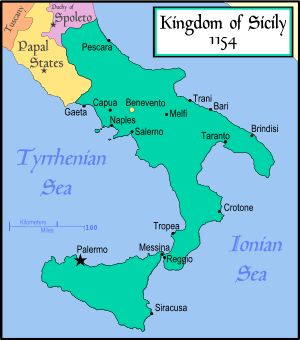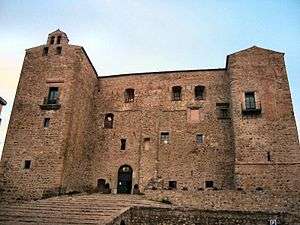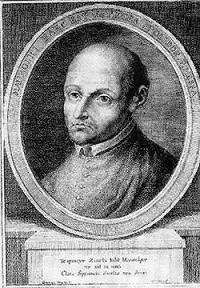House of Ventimiglia
The Ventimiglia are a noble Italian family that once held fiefdoms in Liguria, France, Spain and Southern Italy.

Origin
The Ventimiglia family originated from Cono/Corrado Count of Ventimiglia (10th-11th century), son of Count Cono, likely Count palatine of Vienne, Isère (an Alemannian-Franconian Conradines). Enrico II de Ventimiglia, Count del Maro (Albenga) married around 1250 Isabella/Elisabetta, countess of Geraci (Sicily), establish a new branch in the Hohenstaufen Kingdom of Sicily.

The counts of Geraci derive by the union of Serlone II d'Hauteville, a godson and relative of Ruggero Gran Count of Sicily, and his wife Lady Isabella. This marital union gave origin to the ancestors of Ventimiglia line, the possibles successors of Serlon were: Eliusa, Rinaldo di Bernaville, Rocca di Bernaville, Ruggero I de Creon count of Ischia and Geraci, Guerrera de Creon countess, Ruggero II count of Ischia and Geraci, Aldoino count, Isabella who married Count Enrico II of Ventimiglia son of count Filippo I of Ventimiglia and del Maro. The French branch uses de Vintimille and the Spanish branch uses de Veintimilla, Vintemilla or Veintimiglia (branch of Màlaga).[1]
- Lascaris di Ventimiglia
Another branch, the Lascaris (di Ventimiglia) Conti di Tenda, is descended in female line from the Laskaris of the Empire of Nicaea through the marriage in 1261 of Guglielmo Pietro I, Conte di Ventimiglia, Signore de Tenda (d. 1282) with Eudokia Laskarina (1248–1311), daughter of Emperor Theodore II Laskaris and wife Princess Elena of Bulgaria.[2]
Eudokia was born in Nicaea about 1248, the fourth daughter of Theodoros II Doukas Laskaris, emperor of Byzantium, and Elena of Bulgaria. She grew up as a princess at the court of Nicaea, where Costanza 'Anna' von Hohenstaufen, widow of Eudokia's grandfather Ioannes III Doukas, emperor in Nicaea, also lived. After the Palaiologan usurpation of the imperial throne, both ladies fled, travelling from Constantinople to Tende and Sicily, and years later both sought protection at the kingdom of Aragón under King Jaime I 'the Conqueror'.
Soon after the re-conquest of Constantinople in 1261, Michael VIII Palaiologos, until then regent and co-emperor for the infant Ioannes IV Laskaris, had himself declared sole emperor, solidifying his position by having Ioannes IV blinded and imprisoned. Ioannes' three sisters, Eudokia among them, were hurriedly married off to foreigners, so that their descendants could not lay claim to the imperial succession.
The young Eudokia was married in Constantinople in July 1261 to Guglielmo Pietro de Tenda, count of Ventimiglia et Tende, son of Guglielmo III. Tende was a Ligurian region then at the service of Genoa, allies of Michael VIII. This marriage originated the powerful house Lascaris de Vintimille, which stood until the 19th century. Eudokia and Guglielmo Pietro had several children of whom Giovanni I and Lascara/Lucretia would have progeny.
Eudokia fled from Liguria to Aragón with her children. Some sources say the cause was her husband's death, others that she had been rejected by him. Living at Xàtiva, Saragossa and Castella, Eudokia travelled on diplomatic missions for Jaime II 'the Just', king of Aragón, who succeeded his brother Alfonso III in 1291. In 1296 she founded a convent of the Order of Poor Ladies and the sanctuary of Mare de Déu de la Serra at Montblanc, which she entered by the end of 1306. She also donated an Italian image of the Virgin to the convent. The image can still be seen there. She died in Saragossa in 1311, and her remains rest at the Dominican monastery there.
Members of the family include
- Giovanni I Ventimiglia (1383–1475), eighth count of Geraci (from 1405); Marquess of Geraci from 1436; also Lord of Castelbuono, Tusa, Gangi, San Mauro (San Mauro Castelverde), Pollina, Caronia (from 1412), Cefalù, Sciacca, Termini Imerese, Count of Montesarchio, Bitonto, Casamassima, Serracapriola, Castellamare di Stabia, Orta Nova and Magliano, Baron of Ciminna..., Grande Ammiraglio del Regno (Grand Admiral of Sicily Kingdom), Viceré di Sicilia, (Viceroy of Sicily), 1430–1432, Governatore del Regno di Napoli (Governor of Naples Kingdom), 1435, Viceroy of Duchy Athens and Neopatria, 1444, Regent of Naples Kingdom, 1460, Captain General of the Church, 1445 and 1455.[3]

- Giovanni II Ventimiglia, sixth Marquis of Geraci, (from 1545), awarded by king Charles I of Spain, a.k.a. Holy Roman Emperor Charles V, (1500–1558), in the Island of Sicily, Coordinates: 37°52′N 14°9′E, Baron of Pettineo, island of Sicily, Italy, (from 1529), Coordinates: 37° 58′ 0″ N, 14° 17′ 0″ E, awarded also by king Charles I of Spain, mentioned, Signore of Castelbuono, Tusa, Gangi, Sicily, Tiro, Ciura and Carcinella, Sciara, and Pinola. A keen supporter of the mathematical sciences, President of Sicily, 1595–1598 and 1606 - 1607. Supported the efforts of scientist Francesco Maurolico, (1494–1575).

- Salvatore Ventimiglia (d. Palermo, April 1797), Bishop of Catania, son of the 3rd Princes of Belmonte

- From the Counts and Marquises of Geraci descends the living Prof. Dr. Giovanni Ventimiglia (Palermo 1964), Knight of Honour and Devotion of the Sovereign Military Order of Malta, Knight of Justice of the Sacred Military Constantinian Order of Saint George, full professor of theoretical philosophy at the Faculty of Theology in Lugano, Switzerland, Director of the Department of Philosophy and of the Institute of Philosophical Studies, a philosopher usually associated with analytical Thomism.
- An impoverished branch of this noble house immigrated to the United States.
Notes
- ↑ Some titles held by the lineage Ventimiglia:
- Lord of Tende
- Lord of Vernante
- Lord of Limone Piemonte
- Lord of Nice
- Lord of Riez
- Lord of Ollioules
- Lord of La Verdière
- Lord of Saint-Julien, Var
- Lord of Turriers
- Lord of Revest
- Lord of Vidauban
- Lord of Cefalù
- Lord of Termini Imerese
- Lord of Polizzi Generosa
- Baron of Regiovanni
- Baron of Sperlinga
- Baron of Riesi
- Baron of Barrafranca (Convicino)
- Baron of Prizzi
- Baron of Tusa
- Baron of Roccella Valdemone
- Baron of Gratteri
- Baron of Ciminna
- Baron of Monforte
- Baron of Sinagra
- Baron of Buscemi
- Baron of Passaneto
- Baron of Baida
- Viscount of Marseille
- Count Palatine of the Holy Roman Empire
- Count of Ischia
- Count of Geraci
- Count of Collesano
- Count of Mistretta
- Count of Alcamo
- Count of Naso
- Count of Prades
- Count of Ventimiglia
- Count of Maro
- Count of Malta (1360)
- Count of Le Luc
- Count of Peñon de la Vega (in Spain)
- Marquess of La Martre
- Marquess of Arcs
- Marquess of Vins-sur-Caramy
- Marquess of Savigny-sur-Orge
- Marquess of Geraci
- Marquess of Regiovanni
- Marquess of Sambuca di Sicilia
- Marquess of Alimena
- Marquess of Crópani(in Spain)
- Duke of Saint-Cloud, Peer of France
- Duke of Belviso
- Duke of Misilmeri
- Prince of Belmonte
- Prince of Castelbuono
- Prince of Grammonte
- Prince of Scaletta
- Prince of Belmontino
- Prince of Buonriposo
- Prince of Cattolica
- Prince of Belvedere
- Prince of San Mauro
- Prince of S.Anna - Gisira
- Prince of Valdina
- Prince of Villadorata
- Prince of Ventimiglia di Sicilia
- Prince of Malta and Grandmaster of The Sovereign Military and Hospitaller Order of St. John (1636 - 1657)
- Princes of the Holy Roman Empire with honorific Princely Highness
- Knights of Order of the Golden Fleece, and four times Grandees.
- ↑ The History of the Col de Tenda, W.A.B. Coolidge, The English Historical Review, Vol. XXXI, ed. Reginald Lane Poole, (Longmans, Green and Co., 1916), 202.
- ↑ Maria Antonietta Russo, Giovanni I Ventimiglia: un uomo al servizio della monarchia, "Archivio Storico Siciliano", s. 4., 34-35 (2008-2009), p. 43-93.
Lord of Isnello
Sources
- "Centro Studi Ventimigliani" (in Italian).
External links
- "Histoire généalogique de la maison de Vintimille" (in French).
